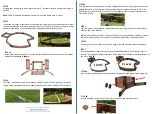
Customer Service: 1800-914-9835 |
© Frame It All. All Rights Reserved.
STEP 9.
As you are molding the liner to the frame, attempt to remove as many folds as possible.
STEP 10.
Consider designing your waterfall feature before adding water to the pond. Once water is
added, your access to the waterfall may be limited making stone placement cumbersome.
STEP 11.
Fill your pond and adjust the liner if needed while the weight of the water is not too much.
As the water fills up, pull your liner to eliminate any wrinkles that may still exist. Once the
pond has been filled, the weight of the water will prevent these wrinkles from returning.
Designing your Waterfall
STEP 1.
Choose the stones you wish for the water to flow over. There are many design options and
stone types you can go with. The classic look and easiest to set up is using flat stones. Flat
stones allow the water to seamlessly glide over making a soothing sheet of water into your
pond.
STEP 2.
If making a multi-step waterfall, reduce the number of cracks in between each step to
maximize the flow of your water down the waterfall.
STEP 3.
Follow your pump assembly instructions included in your pump box. Place your pump
inside of your pond at the furthest point possible from the waterfall. This will maximize
waterflow and filtration. Test how the water will flow over the rocks you have chosen by
changing the position of the tubing while the water is running. Once satisfied, use rocks to
keep the tubing in position.
STEP 4.
Use a pond safe foam sealant to fill in any of the cracks on your waterfall that are
weakening the flow. This will further increase the amount of water that makes it to the spill
way. Exposed foam can be covered with small stones after it has dried for 30-60 minutes.
Landscape Design Suggestions
•
Move your excess soil up to your pond edge and take care to pack soil under any
areas of the edge and then taper your soil grade down from the pond edge. Raising
your pond grade from the grade around will ensure lawn chemicals will not wash
into your ponds water effecting the health of your fish and aquatic plants.
•
If you are looking to reduce the amount of stone in your design, there are a few
tricks you can do. The first is to use tall, dense leaved plants on either side of your
waterfall instead of stone. The second is instead of using stones all around the edge
of your pond, plant low creeping plants up against the pond frame so that plants
grow up and over the lined edge. Sporadically found this will eliminate the necklace
effect you often see in ponds and naturalize your landscape.
•
Before digging my plants into the ground, I place them out where I want them while
they are still in pots. I like to place my plants out first and then place key large
stones in place to get a good idea of where I want things before digging in my plants
and stones.
•
Once you like your placement, set your plants and dig your primary focal stones
partly in the soil to create a more natural look.
•
My focal stones are sometimes placed in different manners to create a mini
mountain scene or a well-placed stone jutting into the pond.
•
After my plants and primary focal stones are in place, I use a combination of mulch
and 2-3 different size stones or pebbles to create a natural look. I try not to over
think the placements of my secondary smaller stones, starting with the largest
stones first then graduating down to the smaller stones.
Customer Service: 1800-914-9835 |
© Frame It All. All Rights Reserved.
See our waterfall building video on YouTube.com/FrameitallVideos for a visual guide on
how to construct your waterfall feature!
Direct Link:






















